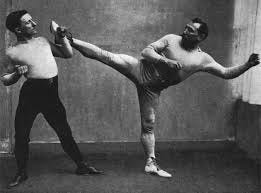We have answers in the West too, you know
The lure of the East has obscured our own fighting arts (and other things too)
Martial arts has been a hobby of mine since I was a teenager, although I only got into training properly in my mid-twenties-ish.
When we think of martial arts, we are immediately drawn to the East. We think of Karate, Kung fu, Muay Thai, etc. The rise of Mixed Martial Arts as a sport has also brought Brazilian Jiu-Jitsu into the wider combat sports/self-defence psyche. But even that is based on the Japanese system of jiu-jitsu. We don’t immediately think of boxing, for example, or wrestling, as martial arts. Rather, they are classified as sports.
The popularity of Eastern fighting codes means that most people in the West who have trained in martial arts over the past 60 years or so, have done so through an Eastern system.
I am guilty —if that is the right word — of going down the same path.
I dabbled a bit in Karate at school and university, and then Taekwon-do for 7/8 years and have studied Wing Chun (a kung fu style) on-and-off since 2012. All of these arts, in their own way, when trained properly, are perfectly adequate fighting systems.
The general preference for Eastern combat techniques, however, has, for some, created an inverse situation for martial arts students. Specifically those who train for self-defence reasons. I guess what I’m trying to say (oh no, here we go — Ed) is that it is ironic that people turn to Eastern martial arts as a way to learn how to defend themselves, rather than Western combat sports.
This is because those who become proficient in boxing and wrestling are probably much better equipped to defend themselves when faced with a physical confrontation than many students of Eastern martial arts. Both boxing and wrestling emphasis competition as the ultimate goal. And if you are in a real boxing or wrestling match, then it can feel like a case of life and death. The other person is trying to hurt you and subdue you. You have to stop them. Simples Sergei. Many eastern systems have competitions too, but they are light contact, or restricted in some other way. What’s more, boxers and wrestlers have to be very fit to compete. Eastern martial arts fighters do not, with the exception of Muay Thai (Thai boxing). Being in top physical condition is a big differentiator. It helps your body cope better when you have to deal with a huge adrenaline dump when attacked and if you have to flee from a scene or assailant.
But why have we been so enamoured by the East and flashy kung fu movies? I suspect it is a combination of mystery, movies and myth.
This is a shame and perhaps shows a lack of belief in some aspects of our heritage.
Take Savate, the French kickboxing art, which may or may not have been developed by drunk French sailors a couple of hundred years ago. How many people outside of France and martial arts circles have heard of it? By all accounts, it was/is a highly-effective self-defence system. In my forthcoming novel The Fragment from The Shroud, the protagonist, Albert Poniatowski, who is descended from the last king of Poland, is an experienced Savate practitioner, and uses his skills to get out of a sticky situation or two.
There are probably a number of systems that we have lost through the mists of time. I’m sure a few soldiers and knights back in the Middle Ages could handle themselves if they happened to lose their sword and shield. And I reckon the Romans would have had some level of basic hand-to-hand combat training too.
Boxing, interestingly, also had throws, sweeps and other such useful techniques prior to introduction of the Queensbury Rules.
But it’s not just in the sphere of martial arts that we turn to readily to the East.
We also have answers in our own cultures that we ignore, in preference for Eastern method, such as:
Natural remedies. We don’t need to consult a Chinese 17th-century manual on herbal medicine. My mother used to put a plant leaf in her ear when she has earache or a headache. I have no idea what the plant was. Could have been Basil. (Ed — are you sure about this?)
Philosophy. Who needs Confucius when you have Aristotle and St Thomas Aquinas?
Curries. Who needs a spicy Thai dish when we have mustard and horseradish sauce? (Ed — what?)
Korean pop and Anime. We have Scandi rock and Asterix and Obelix and Tintin. By the way, Professor Cuthbert Calculus, a character in the Tintin comics, is trained in Savate.
We should have more faith in what we have produced, lost, and could still rediscover in the West.
Progress report:
The needle has not moved much on either my novella The Anchorite (4,305 words), or the editing of my novel The Fragment from The Shroud.
I will try to turbo boost things a little.
Take it easy. And thanks for reading.




